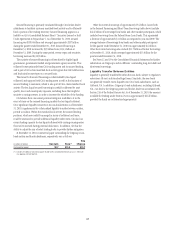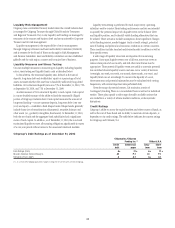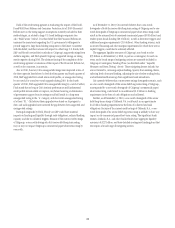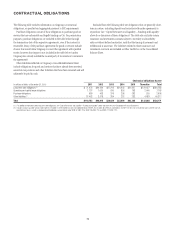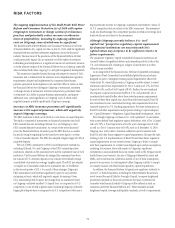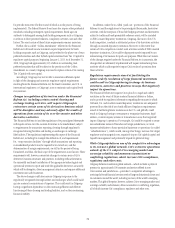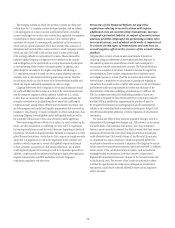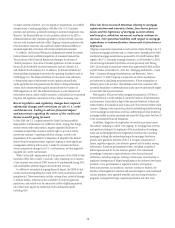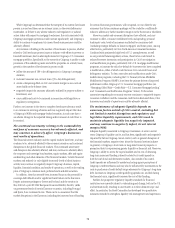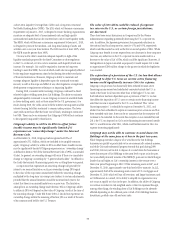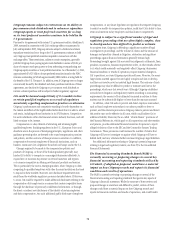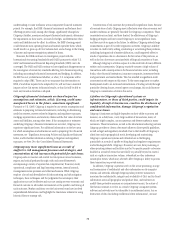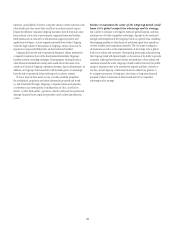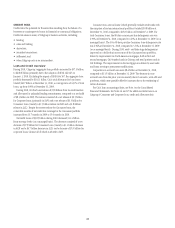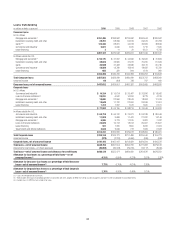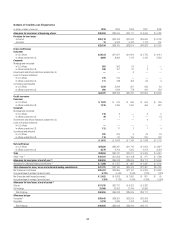Citibank 2010 Annual Report Download - page 79
Download and view the complete annual report
Please find page 79 of the 2010 Citibank annual report below. You can navigate through the pages in the report by either clicking on the pages listed below, or by using the keyword search tool below to find specific information within the annual report.77
a short-term Liquidity Coverage Ratio (LCR) and a long-term, structural
Net Stable Funding Ratio (NSFR). The LCR, which will become a minimum
requirement on January 1, 2015, is designed to ensure banking organizations
maintain an adequate level of unencumbered cash and high quality
unencumbered assets that can be converted into cash to meet liquidity needs.
The NSFR, which will become a minimum requirement by January 1, 2018,
is designed to promote the medium- and long-term funding of assets and
activities over a one-year time horizon. The LCR must be at least 100%, while
the NSFR must be greater than 100%.
Citi may not be able to maintain adequate liquidity in light of the
liquidity standards proposed by the Basel Committee or other regulators
in the U.S. or abroad, or Citi’s costs to maintain such liquidity levels may
increase. For example, Citi could be required to increase its long-term
funding to meet the NSFR, the cost of which could also be negatively effected
by the regulatory requirements aimed at facilitating the orderly resolution
of financial institutions. Moreover, Citigroup’s ability to maintain and
manage adequate liquidity is dependent upon the continued economic
recovery as well as the scope and effect of any other legislative or regulatory
developments or requirements relating to or impacting liquidity.
During 2010, consistent with its strategy, Citigroup continued to divest
relatively higher yielding assets from Citi Holdings. The desire to maintain
adequate liquidity continued to cause Citigroup to invest its available funds
in lower-yielding assets, such as those issued by the U.S. government. As a
result, during 2010, the yields across both the interest-earning assets and the
interest-bearing liabilities continued to remain under pressure. The lower
asset yields more than offset the lower cost of funds, resulting in continued
low NIM. There can be no assurance that Citigroup’s NIM will not continue
to be negatively impacted by these factors.
Citigroup’s ability to utilize its DTAs to offset future
taxable income may be significantly limited if it
experiences an “ownership change” under the Internal
Revenue Code.
As of December 31, 2010, Citigroup had recognized net DTAs of
approximately $52.1 billion, which are included in its tangible common
equity. Citigroup’s ability to utilize its DTAs to offset future taxable income
may be significantly limited if Citigroup experiences an “ownership change”
as defined in Section 382 of the Internal Revenue Code of 1986, as amended
(Code). In general, an ownership change will occur if there is a cumulative
change in Citigroup’s ownership by “5-percent shareholders” (as defined in
the Code) that exceeds 50 percentage points over a rolling three-year period.
A corporation that experiences an ownership change will generally be
subject to an annual limitation on its pre-ownership change DTAs equal
to the value of the corporation immediately before the ownership change,
multiplied by the long-term tax-exempt rate (subject to certain adjustments),
provided that the annual limitation would be increased each year to the
extent that there is an unused limitation in a prior year. The limitation
arising from an ownership change under Section 382 on Citigroup’s ability
to utilize its DTAs will depend on the value of Citigroup’s stock at the time of
the ownership change. Under IRS Notice 2010-2, Citi did not experience an
ownership change within the meaning of Section 382 as a result of the sales
of its common stock held by the U.S. Treasury.
The value of Citi’s DTAs could be reduced if corporate
tax rates in the U.S., or certain foreign jurisdictions,
are decreased.
There have been recent discussions in Congress and by the Obama
Administration regarding potentially decreasing the U.S. corporate tax
rate. In addition, the Japanese government has proposed reductions in
the national and local corporate tax rates by 4.5% and 0.9%, respectively,
which could be enacted as early as the first or second quarter of 2011. While
Citigroup may benefit in some respects from any decreases in these corporate
tax rates, any reduction in the U.S. corporate tax rate would result in a
decrease to the value of Citi’s DTAs, which could be significant. Moreover, if
the legislation in Japan is enacted as proposed, it would require Citi to take
an approximate $200 million charge in the quarter in which the legislation
is so enacted.
The expiration of a provision of the U.S. tax law that allows
Citigroup to defer U.S. taxes on certain active financing
income could significantly increase Citi’s tax expense.
Citigroup’s tax provision has historically been reduced because active
financing income earned and indefinitely reinvested outside the U.S. is
taxed at the lower local tax rate rather than at the higher U.S. tax rate.
Such reduction has been dependent upon a provision of the U.S. tax law
that defers the imposition of U.S. taxes on certain active financing income
until that income is repatriated to the U.S. as a dividend. This “active
financing exception” is scheduled to expire on December 31, 2011, and
while it has been scheduled to expire on numerous prior occasions and has
been extended each time, there can be no assurance that the exception will
continue to be extended. In the event this exception is not extended beyond
2011, the U.S. tax imposed on Citi’s active financing income earned outside
the U.S. would increase after 2011, which could further result in Citi’s tax
expense increasing significantly.
Citigroup may not be able to continue to wind down Citi
Holdings at the same pace as it has in the past two years.
While Citigroup intends to dispose of or wind down the Citi Holdings
businesses as quickly as practicable yet in an economically rational manner,
and while Citi made substantial progress towards this goal during 2009
and 2010, Citi may not be able to dispose of or wind down the businesses or
assets that are part of Citi Holdings at the same level or pace as in the past
two years. BAM primarily consists of the MSSB JV, pursuant to which Morgan
Stanley has call rights on Citi’s ownership interest in the venture over a
three-year period beginning in 2012. Of the remaining assets in SAP, as of
December 31, 2010, approximately one-third are held-to-maturity. In LCL,
approximately half of the remaining assets consist of U.S. mortgages as of
December 31, 2010, which will run off over time, and larger businesses such
as CitiFinancial. As a result, Citi’s ability to simplify its organization may
not occur as rapidly as it has in the past. In addition, the ability of Citigroup
to continue to reduce its risk-weighted assets or limit its expenses through,
among other things, the winding down of Citi Holdings may be adversely
affected depending on the ultimate pace or level of Citi Holdings business
divestitures, portfolio run-offs and asset sales.


